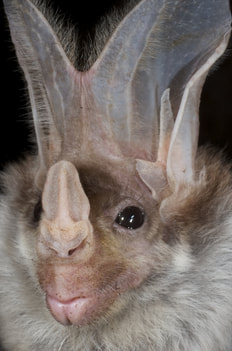Nicola Hanrahan
- PhD Student (completed), Lab of Animal Ecology, Hawkesbury Institute for the Environment, University of Western Sydney
- Topic: The acoustic ecology of the ghost bat (Macroderma gigas): form, function and applied uses of vocalisations
- Supervisors: A/Prof J. Welbergen, Dr Christopher Turbill, Dr Anastasia Dalziell, Dr Kyle Armstrong
- Contact: Nicola Hanrahan
|
Bio
I received a Bachelor of Science (1st class) in Zoology from University College Dublin, Ireland in 2010. My studies involving bats began with my honours thesis which involved the design of a rapid PCR based test which allowed quick and cost effective determination between cryptic European bats species Myotis mystacinus, Myotis alcathoe and Myotis brandtii using DNA obtained from tissue or scats. In 2012, I began work as an ecologist at an environmental consultancy based in the Northern Territory, Australia conducting research mainly in the Top End and the Central Deserts. My work included working with private companies, government departments and non-government organisations conducting environmental impact assessments, targeted threatened species surveys, baseline flora and fauna surveys and rehabilitation surveys. Research
The field of acoustic ecology to date has been dedicated predominantly to the study of vocalisations in birds and cetaceans. Bats, despite evidence that they are capable of producing repertoires of calls comparable to birds, have not had the same treatment. The reasoning for this is likely their cryptic nocturnal habits, difficulty in finding roosts and challenges in analysing ultrasonic sound despite many bat social calls being in the audible range. There is a misconception that bat vocalisations serve only the function of echolocation for finding food and maneuvering around obstacles. Recent studies show that many bats have a range of vocalisations including elaborate songs used for territoriality and mate attraction. New technological advances in acoustic and video surveillance now facilitate research into this highly understudied area. The Ghost Bat (Macroderma gigas) is a large, predominantly carnivorous microbat of the family Megadermatidae found in tropical and sub-tropical Australia. The species has experienced a northward contraction since European settlement from locations in arid Australia, and is undergoing a continuing decline likely due to mining activities and cave disturbance. At present, this species is listed as Vulnerable under the International Union for Conservation of Nature (IUCN), and has recently been proposed to be listed as Vulnerable under the EPBC Act because of continuing and/or projected declines in various parts of its range. As a highly vocal and social species, the ghost at is the ideal model species to study communication and sociality in bats. Specifically, I aim to determine:
|
|
Academic Publications - Google Scholar
HANRAHAN, N., TURBILL, C., DALZIELL, A. H., ARMSTRONG, K. N., & WELBERGEN, J. A. (2023). Calling up ghosts: acoustic playback of social vocalisations reveals complex communication in a cryptic bat and provides a promising tool for monitoring disturbance-sensitive species. Mammal Research, 69:59-69
HANRAHAN, N., TURBILL, C, DALZIELL, A. H., ARMSTRONG, K. N. & WELBERGEN, J. A. (2022). Ethogram of ghost bat (Macroderma gigas) behaviours and associated social vocalisations. Acta Chiropterologica, 24:195-208
HANRAHAN, N., TURBILL, C., ARMSTRONG, K. N., DALZIELL, A. H., & WELBERGEN, J. A. (2021) Ghost bats exhibit informative daily and seasonal temporal patterns in the production of social vocalisations. Australian Journal of Zoology, 67:305-315
Popular Articles
MARTIN, J, WALDIEN, D., NOVERA, J, WELBERGEN J. A., OEDIN, M., HANRAHAN, N., KINGSTON, T. and LAVERY, T. Pacific Island bats are utterly fascinating, yet under threat and overlooked. Meet 4 species. 25-8-2021


